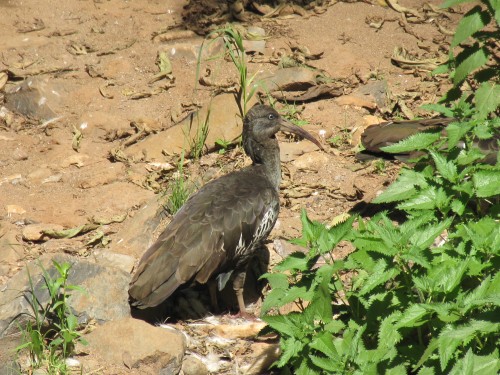Wattled Ibis, Addis Ababa, Ethiopia
One of the interesting birds I saw last December during my stay with my daughter in Addis Ababa was the Wattled Ibis. It was the only species of ibis I saw during my short visit despite the fact that 7 different species can be found in Eastern Africa.
The birds in these photos were taken along the river which flows along one boundary of the school campus where we were staying. Only in the last photo on this page can you easily see the wattle hanging from the throat of the birds. The Wattled Ibis is a bird of the highlands in Ethiopia – usually above 1500 metres – and is quite common. It has also been recorded in nearby Eritrea. While I only saw two birds at a time it is commonly seen in medium sized flocks of 20 – 100.
When feeding it will walk along slowly, prodding the ground for insects, worms, beetles and will take frogs, mice and even small snakes.
Glossy Ibis, Adelaide Zoo
The Glossy Ibis is one of three species of ibis found in Australia. The others are the White Ibis and the Straw-necked Ibis. The glossy is a beautiful bird when one can get up close and see the sunlight shining on its iridescent feathers. In the natural environment it is no easy to get up so close that one can see these feathers glowing. That is why I enjoy places like the walk-through aviary at the Adelaide Zoo which is where I managed the photo above.
The Glossy Ibis has been something of a bogey bird for me. They are widespread throughout the part of South Australia where I live, yet I only saw my first one near the river at Mannum just north of home a few years ago. I have not seen another, so I need to get out birding more often.
Except for the drier parts, the Glossy Ibis is widespread throughout much of Australia where there is suitable habitat. It has a wide range of habitats, including grasslands, swamps, mangroves, wetlands, irrigated pastures, mudflats and flood plains.
Further reading:
Straw-necked Ibis, Adelaide Zoo, South Australia
The Straw-necked Ibis is a very common bird in the Murray Bridge district of South Australia where I live. I have seen flocks numbering in the hundreds flying overhead, and sometimes smaller flocks land to feed in the open paddock opposite our home. On the odd occasion a few will even land on our five acre block.
It is strange then that I did not have a good close-up photo of this species to show here – until last week when I visited Adelaide Zoo and got the above shot in the walk-through aviary. That’s bird photography for you. I have photos of species I never expected to get, and none of some common species. [Sigh]
The Straw-necked Ibis is a widespread species in northern and eastern Australia and is expanding its range in Western Australia and Tasmania. Within its range it is found in freshwater and saline wetlands, tidal mudflats and swamps. It has adapted to life in pastures and other irrigated areas, lawns, ovals, public parks and gardens.
Ibis Rookery, Kerang, Victoria
Whenever we travel through Kerang in north west Victoria we try to make time to stop at the Ibis Rookery. This is part of a series of lakes fed by the River Murray. It is an important wetland area and supports large numbers of water birds.
The rookery itself is a few kilometres north of the town on the way to Swan Hill. It is about a kilometre off the main road with easy access to the picnic ground. A short two minute walk from the car park gets one to the bird hide, complete with a telescope for birders – and the general public – to use.
Straw-necked Ibis
Straw-necked Ibis are very common in the Murray Bridge district. It is quite easy to find loose flocks of dozens through to several hundred feeding in paddocks in this area. The river flats which are irrigated from the River Murray are regular places where these birds congregate. When food is scarce on the river flats, these birds can be seen flying in formation off to farming land away from the river.
There are two types of Ibis common to this area. The Straw-necked and the White Ibis. Occasionally the Glossy Ibis can be found in this district as well, but it is uncommon. In fact, I’ve only ever seen one in over twenty five years.
Today we observed a flock of about 70 Straw-necked Ibis land and begin feeding in the paddock opposite our driveway. This is noteworthy because they rarely come to that particular paddock; I’m not sure why. In the photo above you can see them resting a feeding. If I’d tried to get a closer photo I would have scared them away as there was no cover for me.
The photo also shows a male House Sparrow (out of focus) sitting on the fence post in the foreground. It also shows several large hay bales which the farmer had recently made. In the background the trees are the arboretum of the State Flora branch here. This is a commercial nursery supplying forestry needs as well as smaller nurseries and the general public.
Ibis often fly over head in large numbers. To my knowledge, on only one occasion has a Straw-necked Ibis landed on our five acre block of land. This individual is shown below.









